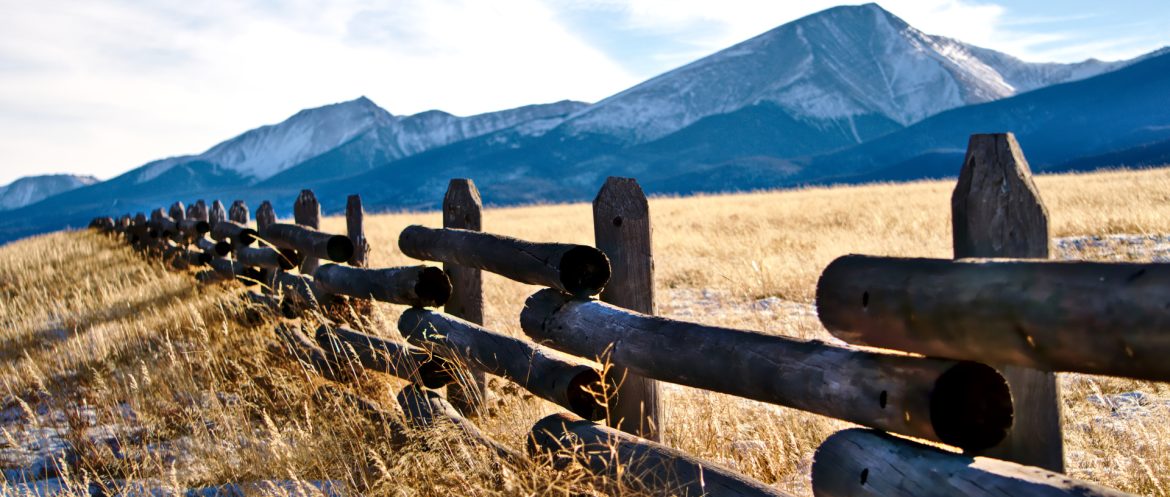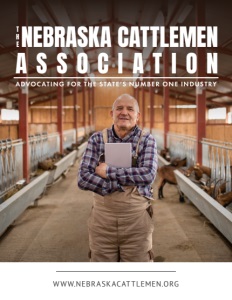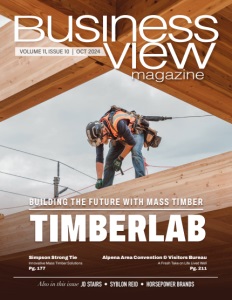The Nebraska Cattlemen Association
Advocating for the state’s number one industry
“Good Life – Great Steaks”
The population of Nebraska is about two million people. And about six-and-a-half million cows. About two thirds of the people live in metropolitan areas. The rest, and presumably all of the cows, populate some 45,000 farms and ranches spread out across the 77,000 square miles of the Cornhusker State. Agriculture is Nebraska’s leading industry and cattle production is its largest segment, contributing over $13 billion a year to the state’s economy.
While the Nebraska territory had historically served as a market for beef headed east by rail, cattle ranching came to the state in the late 19th century as stockgrowers from Texas and other cattle producing regions began looking for additional open range for their herds. And with its abundance of forage and water, the vast grasslands of the Sand Hills in north-central Nebraska provided an ideal environment for raising cattle.
Representing the vital cattle industry is the role that the Cattlemen Association plays with success. A grass-roots, membership, advocacy and policy organization, governed by a Board of Directors, and committed to protecting the interests of Nebraska’s beef cattle producers as well as all other sectors of the cattle industry at the local, state, and federal levels. The association has about 3,500 members and represents 43 local affiliate associations across nine state regions. Its mission is to connect all the stakeholders in the cattle industry from “pasture to plate,” in order to best advocate for their policy goals.
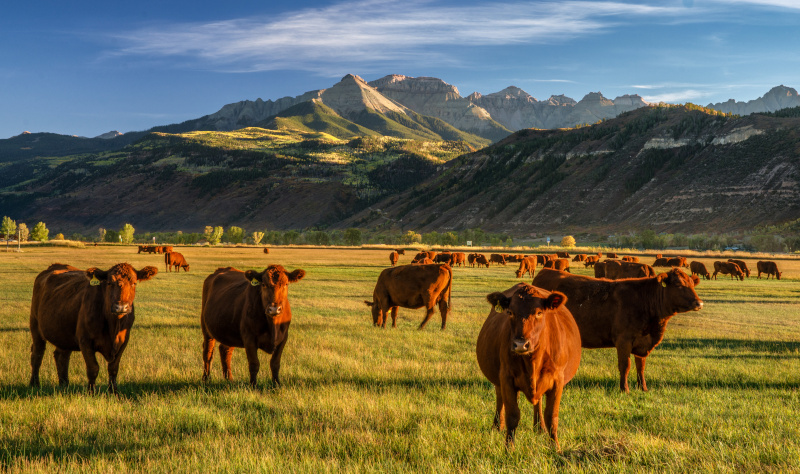
An all-encompassing organization
“Something that sets Nebraska Cattlemen apart from other cattle associations in other states is that we have every segment of the industry,” says Libby Schaneman, Director of Communications and Federal Government Affairs.
“We have producers, we have people who are involved in the cow/calf production side of the industry and those involved in the feeding industry. And we have our allied industry council for business people who are not working on a ranch, but own businesses that support our membership and are engaged with our policy making process.”
“People on a national level watch our policy book and how our members and our association respond to policy issues, because we don’t just have input from our cow/calf side or our meat processors. We have input from everyone across every sector, which requires us all to come to the table and have important conversations, especially when different segments may not agree on some issues, and still find common ground.”
“In our membership, we have six policy committees,” explains Executive Vice President, Laura Field. (Those committees are: Brand and Property Rights, Animal Health and Nutrition, Education and Research, Marketing and Commerce, Natural Resources and Environment, and Taxation.)
“Every member has a reason to be engaged. Every member has a vote. We have an annual meeting and we say, ‘If your voice is not being heard, it’s because you’re not at the table.’ We think that if you’re in the cattle business in Nebraska, you need to be at our table, bringing us your perspective. We don’t always see eye to eye on things, but it’s imperative for the success of the industry, as a whole, that we are all sitting there trying to come up with solutions.”
The org chart
Nebraska Cattlemen has about 10 staff members and Field says it is growing. “We have members of our team that work on government affairs issues at all levels,” she notes.
“We also do quite a bit of education for producers, so we have an education team. We have a communications team that helps us get the messages out because, as a membership organization, it’s key that we keep and grow the membership.”
“We also have a unique and specialized team of staff members who work in the area of cattle marketing, so we have the Market Reporting Service, which gives real-time marketing data so our members can see what the trends are looking like and communicate with their fellow producers, regionally, about what they’re seeing in their areas,” she elaborates.
The Nebraska Cattlemen also publishes a monthly magazine, which is sent to nearly 80% of all beef producers in the state. Its features emphasize business management and include topics such as marketing, genetics, nutrition, forage and pasture management, and animal health. It also includes personality profiles, coverage of Nebraska Cattlemen activities, and comments on issues important to the cattlemen of the state and beyond.
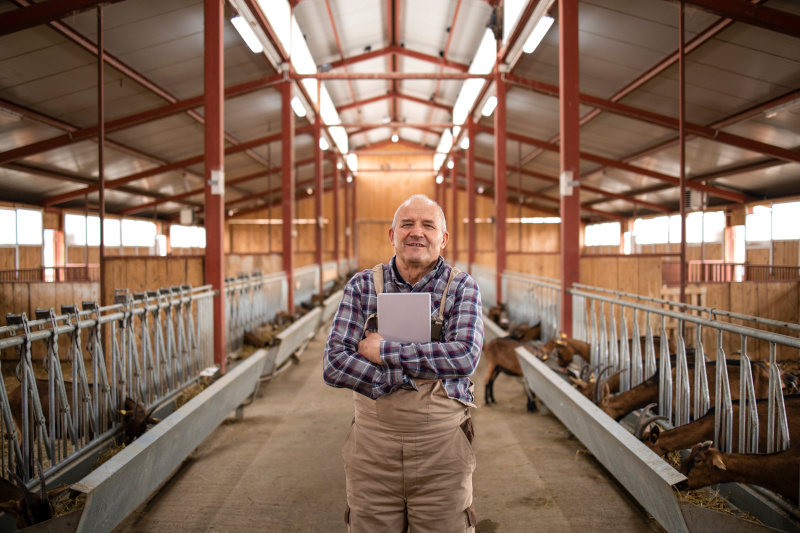
Current policy issues
Field asserts that an important focus of the Nebraska Cattlemen is defending its members “against policies that hurt the industry. Right now,” she says, “we’ve been watching very closely what’s happening at the federal level with the U.S. Farm Bill (the current bill expires at the end of September). We need a farm bill to be in place to help producers know what certainties are ahead of them. Also, we work hard to try and make sure that farm bills and other policies like that have funding for risk management and disasters.”
“We know it’s not ‘if’ the next thing is going to happen, but ‘when.’ We know there’s going to be drought, floods, blizzards, so our members need to know where to go to apply for those funds, if available. And we’re paying a lot of attention to funding for the National Vaccine Bank. If there’s ever an animal disease outbreak, we want to make sure that we have funding in place so we’re prepared for those disasters before they hit us,”Field adds.
Other issues include “making sure that we keep a friendly tax climate for future generations; preserving farms and ranches so people can pass them on to the next generation,” Field adds. “We also want to make sure that we can keep a strong Beef Checkoff in place.” The Beef Checkoff program is a national marketing and research program designed to increase the demand for beef at home and abroad. It supports initiatives such as consumer advertising, marketing partnerships, public relations, education, research, and new-product development. “We want a successful program to keep beef at ‘the center of the plate.’ And we’re always working to make sure that market access remains open; making sure that we have access to get U.S. beef in front of people.”
The association has also worked to deal with some problems that have arisen under provisions of the federal government’s Clean Water Act, which established a permit system to control the release of pollutants into the nation’s waters. “A lot of cattle operations are heavily permitted,” Field reports, “which we’re not unhappy about; permitting is important because we have to make sure we’re protecting water and air. But, sometimes, the burdens that come with that don’t always make sense and are difficult for cattle producers. So, we want to make sure we’re in those conversations.
“We’re also always watching things around endangered species and environmental protections. It sounds good to say, ‘we’re going to protect that species,’ or ‘we’re going to try to keep those lands going.’ But sometimes, expanding that bureaucratic red tape is really hard for producers, who also care about the environment. In fact, cow producers are the original conservationists. Cattle are grazing lands for which there are no other uses, which is a vital tool in managing our landscape. And we’re using good genetics to grow good cows and that means we’re decreasing emissions. We’ve seen emissions decrease by 40% since the 1960s.”
Finally, on the state level, Field says that the number-one issue that affects cattle producers in Nebraska is high property taxes. “The one thing that we’re unified about is that our property taxes are too high,” she states. “It’s an incredibly important issue for us; that we remind folks that agriculture is a business. The cattle business is not any different than a main street business in the city where you have to pay rent, hire attorneys, accountants, etc. Cattle producers do the same thing and they need a climate where they can operate. So, we spend a lot of our time working on tax reform in the state and how we can make sure that you’re not having to sell your ranch just to be able to afford to pay your taxes. We really work hard on that advocacy here at the state level.”
Current Trends
Over the past several years, a number of cattle producers across the state have ventured into the direct-to-consumer market. Field is always ready to talk to those members and then tell their story to other cattlemen and the public at large. “It’s one of our favorite things to do here,” she declares. “’Every steak has a story,’ we like to say. Direct–to-consumer is something that gives producers a chance to tell their story; it gives them a chance to talk face-to-face with their end users and tell them their production story and why it’s important. It’s one thing to walk in and buy your steak at the grocery store, and those grocery interactions are important too, but it didn’t just end up there by happenstance. Every step of the food chain is important; if you’re buying in mass quantities, if you sell directly to someone, there’s always a production story.”
“We have some members who have done it very successfully,” Schaneman adds, “and it’s interesting to watch their marketing strategies. But we support all the ways that our members choose to market and sell their beef.” Direct-to-consumer is still a small part of the beef market. Traditional ways include the sale barn and neighbor-to-neighbor sales. “We’re a small state, population-wise; so everyone has a connection to everyone,” says Field. “When you meet someone, they probably know, or are related to, the person you’re talking about. And ranchers, as a community in Nebraska, have worked hard to find those avenues of connection.”
Another current trend is the increasing use of social media, especially to transmit video footage taken by airborne drones of owners’ herds, and local water, land, and weather conditions, etc. “We’ve seen more and more people using those channels and it’s fun to watch them tell their stories,” says Field.
“We have the recipe for success here,” Field says in conclusion. “Nebraska is where all things come together in the cattle industry; we have the climate, access to market, and good crops that provide feed sources. Our moniker is ‘The Beef State,’ and our state motto is: ‘Nebraska – the Good LIfe.’ So we like to say: ‘Good Life – Great Steaks.’”
AT A GLANCE
The Nebraska Cattlemen Association
WHAT: A member-driven trade association representing the state’s cattle industry
WHERE: Headquarters in Lincoln, Nebraska
WEBSITE: www.nebraskacattlemen.org
